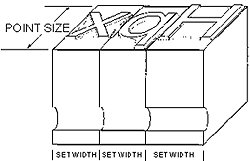Originally, every character was cast as a block of metal type. Two dimensions are of particular interest to today's designer: set-width and point size.
 |  |
Points and Picas
- Points are very small units used to measure both the type size and the space between the lines of type.
- Picas, which are the larger unit, are used to measure the length of a line of type.
- There are 12 points in 1 pica and approximately 6 picas in 1 inch.
Measuring Type in Points
- The width, called the set-width, is determined by the particular letterform itself. The M and W are the widest, and the i and punctuation marks are the most narrow.
- It is the depth of the block that designates the size of metal type. This dimension is generally referred to as type size or point size.
- Since no individual letter fills the entire body, merely measuring the printed letter will not reveal the point size.
Traditional Type Sizes
- Metal type was cast in a range of specific sizes between 5 and 72 points.
- Type sizes were divided into two categories: text type and display type.
- The text type sizes, designed for genral reading, were 5, 6, 7, 8, 9, 10, 11, 12, and 14.
- The traditional display sizes, designed for headlines and large type usage, were 16, 18, 20, 24, 30, 36, 42, 48, 54, 60, and 72 points.
X-height
- The x-height-not the point size of a typeface-conveys the visual impression of the type size.
Linespacing, Leading
- Strips of metal were originally used to create spaces between lines
- Type measurements are often shown with the type size plus the linespacing, i.e., 18/24 is the designation for an 18 point typeface with 24 point leading, normal 18 point leading would be 18/18. This is the measurement from baseline to baseline.
Letterspacing and Wordspacing
- the space between letters and words
- adjusting these attributes changes the color of the printed piece, i.e. darker color is produced when characters are set close together and lighter color is produced when the typesetter opens up the spaces
- Spacing was traditionally specified with the following general terms: normal, loose (or open), tight, very tight, or touching.
- Adjusting the spacing between letters specific letters is referred to as kerning.
Linelength in Picas
- The pica is used to indicate the length of a line of type-called the linelength or measure
- to designate size of type, leading and linelength when using 18 point type with 24 point leading and a 20 pica linelength one would write: 18/24 x 20
Em-Quads, Units, and Set-Widths
-
- Em-Quads.
The em-quad is the square of a specific type size and therefore varies according to type size. These were used as spacers in metal typesetting and, like leads, did not print. These are mostly used to set the indent at the beginning of a paragraph.
Units.A subdivision of the em-quad for use in modern typesetting.
Set-Width.The specific amount of space that a character and a slight amount of space occupies which is measurable in units.
|